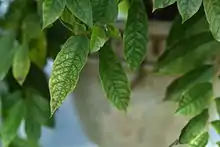Uvaria
Uvaria is a genus of flowering plants in the soursop family, Annonaceae. The generic name uvaria is derived from the Latin uva meaning grape, likely because the edible fruit of some species in the genus resemble grapes.
| Uvaria | |
|---|---|
 | |
| Uvaria chamae | |
| Scientific classification | |
| Kingdom: | Plantae |
| Clade: | Tracheophytes |
| Clade: | Angiosperms |
| Clade: | Magnoliids |
| Order: | Magnoliales |
| Family: | Annonaceae |
| Subfamily: | Annonoideae |
| Genus: | Uvaria L.[1] |
| Species | |
|
See text. | |
| Synonyms | |
|
Armenteria Thouars ex Baill. | |
Species are distributed throughout the Old World tropics.[2] This large genus had about 150 species,[2] but recent molecular analyses have revealed that several smaller genera belong within Uvaria, increasing its size.[3]
These are climbing shrubs or small trees. The flowers are borne singly, in pairs, or in small clusters. There are six petals in two whorls and many stamens.[2]
Selected species
Species in the genus include[4][5]
- Uvaria bathiei Ghesq. ex Cavaco & Keraudren
- Uvaria calamistrata Hance
- Uvaria chamae P.Beauv. – Finger-root
- Uvaria cinerascens (Miq.) L.L.Zhou, Y.C.F.Su & R.M.K.Saunders
- Uvaria cuneifolia (Hook.f. & Thomson) L.L.Zhou, Y.C.F.Su & R.M.K.Saunders
- Uvaria dasoclema L.L.Zhou, Y.C.F.Su & R.M.K.Saunders
- Uvaria flexuosa Jovet-Ast
- Uvaria forbesii (Baker f.) L.L.Zhou, Y.C.F.Su & R.M.K.Saunders
- Uvaria grandiflora (Lesch. ex DC.) Roxb.
- Uvaria griffithii L.L.Zhou, Y.C.F.Su & R.M.K.Saunders
- Uvaria hahnii (Finet & Gagnep.) J.Sinclair
- Uvaria kweichowensis P.T.Li
- Uvaria leandrii Ghesq. ex Cavaco & Keraudren
- Uvaria leptopoda (King) J.Sinclair
- Uvaria leichhardtii (F.Muell.) L.L.Zhou, Y.C.F.Su & R.M.K.Saunders
- Uvaria oligocarpa (Diels) L.L.Zhou, Y.C.F.Su & R.M.K.Saunders
- Uvaria ovata DC.
- Uvaria papuasica (Diels) L.L.Zhou, Y.C.F.Su & R.M.K.Saunders
- Uvaria purpurea Blume
- Uvaria rupestris (Jessup) L.L.Zhou, Y.C.F.Su & R.M.K.Saunders
- Uvaria rufa (Dunal) Blume; Susung-kalabaw
- Uvaria sankowskyi L.L.Zhou, Y.C.F.Su & R.M.K.Saunders
- Uvaria scabridula ((Jessup) L.L.Zhou, Y.C.F.Su & R.M.K.Saunders
- Uvaria scandens C.B.Rob.
- Uvaria schefferi L.L.Zhou, Y.C.F.Su & R.M.K.Saunders
- Uvaria siamensis (Scheff.) L.L.Zhou, Y.C.F.Su & R.M.K.Saunders
- Uvaria sorzogonensis C. Presl
- Uvaria topazensis (Jessup) L.L.Zhou, Y.C.F.Su & R.M.K.Saunders
- Uvaria uhrii (F.Muell.) L.L.Zhou, Y.C.F.Su & R.M.K.Saunders
- Uvaria unguiculata (Jessup) L.L.Zhou, Y.C.F.Su & R.M.K.Saunders
- Uvaria utteridgei L.L.Zhou, Y.C.F.Su & R.M.K.Saunders
- Uvaria wrayi (King) Y.C.F.Su & R.M.K.Saunders
- Uvaria zeylanica
Formerly placed here
- Alphonsea lutea (Roxb.) Hook.f. & Thomson (as U. lutea Roxb.)
- Kadsura heteroclita (Roxb.) Craib (as U. heteroclita Roxb.)
- Kadsura japonica (L.) Dunal (as U. japonica L.)
- Cananga odorata (Lam.) Hook.f. & Thomson (as U. odorata Lam.)
- Miliusa tomentosa (Roxb.) J.Sinclair (as U. tomentosa Roxb.)
- Oxandra lanceolata (Sw.) Baill. (as U. lanceolata Sw.)
- Oxandra laurifolia (Sw.) A.Rich. (as U. laurifolia Sw.)
- Polyalthia cerasoides (Roxb.) Bedd. (as U. cerasoides Roxb.)
- Polyalthia longifolia (Sonn.) Thwaites (as U. longifolia Sonn.)
- Polyalthia suberosa (Roxb.) Thwaites (as U. suberosa Roxb.)
- Xylopia aromatica (Lam.) Mart. (as U. aromatica Lam.)[4]

References
| Wikimedia Commons has media related to Uvaria. |
| Wikispecies has information related to Uvaria. |
- Germplasm Resources Information Network (GRIN) (1996-09-17). "Genus: Uvaria L." Taxonomy for Plants. USDA, ARS, National Genetic Resources Program, National Germplasm Resources Laboratory, Beltsville, Maryland. Retrieved 2008-04-19.
- Uvaria. Flora of China.
- LinLin, Z., Su, Y. C. F., & Saunders, R. M. K. (2009). Molecular phylogenetic support for a broader delimitation of Uvaria (Annonaceae), inclusive of Anomianthus, Cyathostemma, Ellipeia, Ellipeiopsis and Rauwenhoffia. Systematics and Biodiversity, 7(3), 249-258.
- Germplasm Resources Information Network (GRIN). "GRIN Species Records of Uvaria". Taxonomy for Plants. USDA, ARS, National Genetic Resources Program, National Germplasm Resources Laboratory, Beltsville, Maryland. Retrieved 2010-11-20.
- "Uvaria L." Plants of the World Online. The Trustees of the Royal Botanic Gardens, Kew. n.d. Retrieved June 1, 2020.
